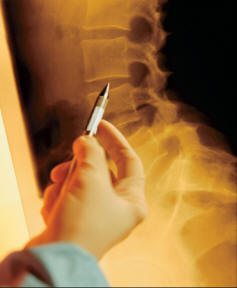What is Prolotherapy?
 Prolotherapy is the non-surgical reconstruction of ligaments (which hold bone to bone), tendons (which hold muscle to bone) and the fibro-osseous junction (where ligament and tendon attach). In the vast majority of cases, these three structures are the source of chronic musculoskeletal pain from injury or weakened tissue. Pain develops when stretching occurs due to ligament laxity, when a ligament or tendon is torn off of the fibro-osseous junction or when poor healing has taken place. The nerve endings that cause pain are pulled along with these stretching structures that signal pain to your brain. Treatment with Prolotherapy repairs these structures so that pain-free or near pain-free movement can occur. Prolotherapy treats the underlying cause of musculoskeletal injury by strengthening these structures. This leads to restored function, reduced pain and improved quality of life.
Prolotherapy is the non-surgical reconstruction of ligaments (which hold bone to bone), tendons (which hold muscle to bone) and the fibro-osseous junction (where ligament and tendon attach). In the vast majority of cases, these three structures are the source of chronic musculoskeletal pain from injury or weakened tissue. Pain develops when stretching occurs due to ligament laxity, when a ligament or tendon is torn off of the fibro-osseous junction or when poor healing has taken place. The nerve endings that cause pain are pulled along with these stretching structures that signal pain to your brain. Treatment with Prolotherapy repairs these structures so that pain-free or near pain-free movement can occur. Prolotherapy treats the underlying cause of musculoskeletal injury by strengthening these structures. This leads to restored function, reduced pain and improved quality of life.
Prolotherapy promotes the innate ability of the body to heal itself normally with healthy, strong tissue and without scarring. Prolotherapy began being used extensively again in the 1920’s by both osteopathic (D.O.) and allopathic (M.D.) doctors. It is used even more often today because of its success rate when conventional treatments have failed – treatments such as physical therapy, antiinflammatories combined with rest, acupuncture, repeated manipulation and surgery. George Hackett, M.D. (considered the founding father of Prolotherapy) reported a cure rate of greater than ninety percent and that eighty-two percent of his patients stated that they considered themselves still cured after a twelve year period of time.
Learn more: New York Times, “Injections to Kick-Start Tissue Repair”
How does it work?
Prolotherapy uses formulated solutions that are introduced into the fibro-osseous junction (a safe area to inject) and create a wound-like environment (inflammation) that stimulates the healing cascade of the body. The usual solution is dextrose (an osmotic agent that initiates inflammation). The dextrose acts as a growth factor stimulant (examples are EpogenTM-red blood cells and NeupogenTM-white blood cells) that works at the nuclear level to trigger the movement of specialized cells toward the site of inflammation. The highlight of this process occurs when the fibroblast cell is attracted to the damaged area and lays down healthy collagen. Collagen is the primary component of ligament, tendon and the fibroosseous junction which enhances the integrity of these structures. It is this proliferation (growth) of new cells that strengthens these structures. Hence the name Prolotherapy and the concept of tissue reconstruction and regeneration.
Biopsies have shown a forty percent diameter increase in overall collagen gain with Prolotherapy which was estimated to double the strength of the tissue. Significant collagen deposition requires about forty-two days (six weeks) and will fully mature in six to nine months.
What Conditions can be treated?
Prolotherapy treats chronic pain from musculoskeletal injuries, especially those injuries that have not responded to surgery or conventional treatment protocols. Specific ailments include, but are not limited to, sport, automobile or recreational injuries, work related injuries, rotator cuff injuries, overuse injuries in children, osteoarthritis, “sciatica”, migraine headaches, whiplash injuries, temporomandibular joint (TMJ) dysfunction, recurrent pain, joint pain, plantar fasciitis, tennis elbow, slipping rib, and disc problems. The vast majority of injuries heal naturally. However a small population of patients progress to a chronic injury state. This can occur for several reasons; poor circulation at the fibro-osseous junction, overuse of anti-inflammatory medicines (e.g. aspirin, MotrinTM, AleveTM, CelebrexTM, VioxxTM etc.) or engaging in activities that continue to aggravate the injury and prevent natural healing. Prolotherapy can also treat and shorten the rehabilitation course of acute, but persistent pain from muscoluskeletal injuries, which did not resolve despite 6-8 weeks of rest.
Treatments For:
- Sciatica
- Arthritis
- Recurrent Pain
- Chronic Pain
- Acute Pain
- Whiplash
- Tennis Elbow
- Plantar Fasciitis
- Disc Problems
- TMJ Dysfunction
- Shoulder, Knee, Elbow, Hands, Feet, Back, Neck & Hip Pains
- Joint Pain
- Overuse Injuries in
- Children and Adults
- Migraine Headaches
- Rotator Cuff Injuries
- Sports Injuries
- Automobile Injuries
- Recreational Injuries
- Work Related Injuries
- …and other Musculoskeletal Injuries

 1367 Avocado Newport Beach, CA 92660 -
1367 Avocado Newport Beach, CA 92660 - 


